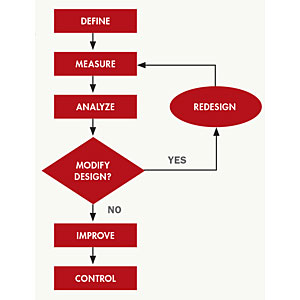When challenged to improve efficiency, increase safety, and save money, Boston Scientific Heredia’s Amplatz Super Stiff Guidewires area team chose a DMAIC roadmap to reach its goal. At roughly the same time, a pharmaceutical company combined DMAIC with other Lean Six Sigma tools to improve equipment effectiveness.
DMAIC is an acronym for a process that covers the following steps: Define, Measure, Analyze, Improve and Control.
A Closer Look at DMAIC
The following description is an excerpt from The Certified Quality Engineer Handbook, Third Edition, ed. Connie M. Borror, ASQ Quality Press, 2009, DMAIC is a data-driven quality strategy used to improve processes. It is an integral part of a Six Sigma initiative, but in general can be implemented as a standalone quality improvement procedure or as part of other process improvement initiatives such as lean. DMAIC is an acronym for the five phases that make up the process: Define the problem, improvement activity, opportunity for improvement, the project goals, and customer (internal and external) requirements. Measure process performance.
Analyze the process to determine root causes of variation, poor
Improve process performance by addressing and eliminating the Control the improved process and future process performance. The DMAIC process easily lends itself to the project approach to quality improvement encouraged and promoted by Juran. |
The process, or roadmap, is often used within the Six Sigma or Lean Six Sigma toolbox but can be used as a standalone tool. It is one of those tools that is almost always referred to as an acronym.
The two projects listed above are case study reports that can be found on the ASQ website (“Mega Pack Line Blow-Up: DMAIC Roadmap Leads Boston Scientific Heredia to Reengineer Packaging Lines” and “Quality Quandaries: Improving the Overall Equipment Effectiveness at a Pharmaceutical Company,” respectively) in the Knowledge Center Case Studies tab. The short story for both projects is that the quality teams saw great benefit in using DMAIC to meet their goals.
In the case of Boston Scientific, the quality team worked to improve efficiency, increase safety, and save $100,000 per year. For the pharmaceutical company, the Six Sigma Black Belt project leader helped improve the effectiveness of the machines by approximately 16%, leading to a savings of €2 million (US$2,367,242) each year.
These results certainly are encouraging but the caution we need to take from these and many other such case studies is that, while DMAIC is a powerful tool, it is not a tool for all projects.
In “To DMAIC or Not to DMAIC?” (Quality Progress, November 2012, Article Here) Carl F. Berardinelli explains, “… if the problem is complex or the risks are high, DMAIC should be the go-to method. Its discipline discourages a team from skipping crucial steps and increases the chances of a successful project, making DMAIC a process most projects should follow.”
Berardinelli also describes that DMAIC is ideal because “it is a data-driven, customer-focused, structured problem-solving framework, It builds on learning from previous phases to arrive at permanent solutions for difficult problems.”
With these cautions in mind, in facing challenging process issues, be sure to consider DMAIC as a viable tool choice. Thorough and effective, DMAIC challenges your organization’s (or client’s) thinking, keeps the improvement process moving, and brings impressive results.









